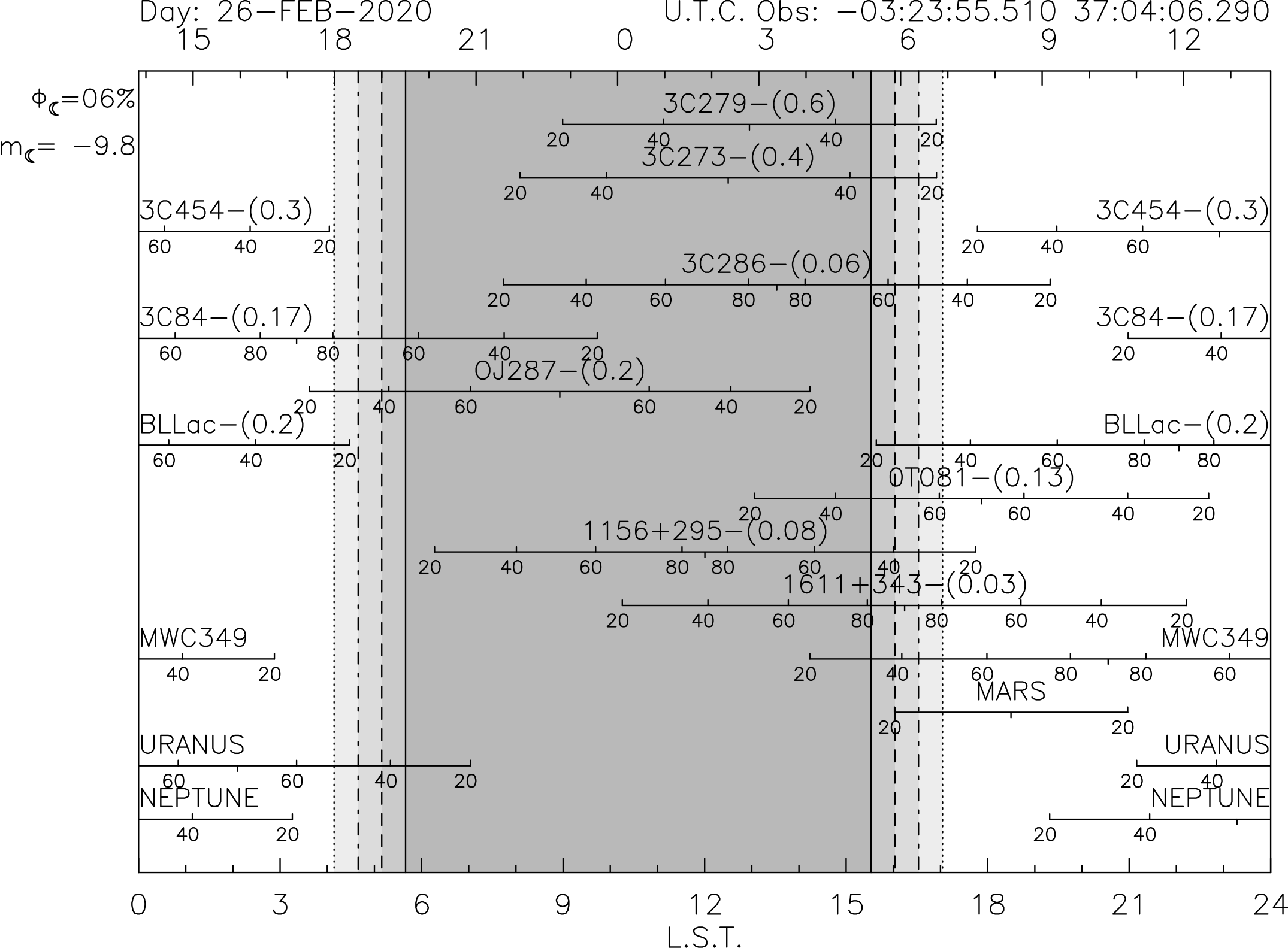Leakage:
At that time of the year, Mars is at low elevation in the morning and Uranus transiting At high elevations in the afternoon: as discussed yesterday this is not optimal to get the best focused observations we need to produce leakage maps at different elevations, but using Mars at low elevations in the morning mitigates this issue. We need at least 3 independent points in each elevation bin to make sure we have a consistent pattern repeating at a given elevation, and use this leakage to correct our data. We suspect we will have to do this as late in the afternoon as possible to have very stable atmosphere, when the source sets from 70 deg down to 20 deg. So these observations will required at least 3 days of excellent weather.
Polarization Angles:
We need simultaneous (same day) observations with XPOL and NIKA2 of strongly polarized sources (not too much affected by leakage variation with El). And the XPOL observations need to be deep enough to achieve high SNR detections at 1mm for comparison with NIKA2-Pol measurements. This will require a couple of days to be carried out in a set of 3-5 quasars with strong polarization (for example 3C286 transiting in the night).
Science verification on extended emission:
We will go for Crab, OMC1 (transiting at sunset), DR21 (transiting in the morning) to check the results against the data obtained in December 2018 and hence validate the repeatability of NIKA2-Pol. Ideally, we also need to observe fainter/less extended sources such as IRAS4A and B335 whose polarization has also been extensively studied and can be compared to existing data in the literature. Altogether these observations will also require 1.5 days.
Visibilities of sources:

*Notes on QSO status (Feb 24): new POLAMI obs analyzed by Iannis, here below the QSOs with polarized flux >100 mJy at 1mm
Source lambda last_obs_ Stokes_I_ LP_degree_ angle_ CP_degree_ LP_flux_Jy 1253-055 1.3mm 13-Jan-2020 8.42 +/- 0.42 7.7 +/- 1.8 26.2 +/- 6.6 -0.7 +/- 0.5 0.64834 1226+023 1.3mm 7-Jan-2020 5.40 +/- 0.27 6.7 +/- 1.8 131.5 +/- 7.6 -0.2 +/- 0.5 0.3618 0851+202 1.3mm 7-Jan-2020 3.45 +/- 0.17 6.8 +/- 1.9 147.3 +/- 7.0 -0.4 +/- 0.6 0.2346 2200+420 1.3mm 17-Feb-2020 2.49 +/- 0.13 7.8 +/- 1.6 0.8 +/- 7.4 -0.9 +/- 0.6 0.19422 0316+413 1.3mm 17-Feb-2020 6.13 +/- 0.31 2.9 +/- 1.9 119.5 +/- 14.0 -0.3 +/- 0.5 0.17777 1749+096 1.3mm 17-Feb-2020 2.14 +/- 0.11 6.4 +/- 2.0 57.9 +/- 7.2 0.1 +/- 0.6 0.13696
- Notes on QSO status (Feb 19) #Don't go to 3C286, too weak. #POLAMI observations from Feb 17 are being analyzed by Ioannis: do not expect other strongly polarized QSOs than the usual 3C273, 3C279 and 3C454.3
From already available measurements:
3C 454.3 had 6% polarization in December 2019 (I 5Jy) but seems not detected in February obs = This is POLAMI B2251+158 and ALMA J2253+1608
3C 279 had 8% polarization in January 2020 (I 8.4Jy) = This is POLAMI B1253-055 and ALMA J1256-0547
3C 273 had 7% polarization in January 2020 (I 5.4Jy) = This is POLAMI B1226+023 and ALMA J1229+0203
- #Other high pol. sources:
B1156+295 had 25% polarization in January 2020 (but I 0.3Jy)
B0219+428 had 14% polarization in December 2019 (but I 0.27Jy) = This is 3C66 A
3C84 had 9% polarization in January 2020 (but I 0.5Jy) = This is POLAMI B0316+413 and ALMA J0319+4130
B0827+243 had 9% polarization in January 2020 (but I 0.35Jy)
B1611+343 had 9% polarization in January 2020 (but I 0.47Jy)
#ALMA obs at 1mm done in January (closed for altiplanic winter since Jan. 29) suggest the following QSOs had polarized flux >0.1 Jy: J1256-0547, J0522-3627, J2253+1608, J2158-1501, J0854+2006, J1229+0203, J0319+4130, J1924-2914, J1337-1257, J2258-2758, J0423-0120
